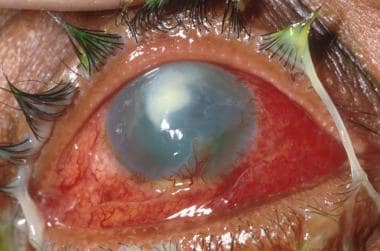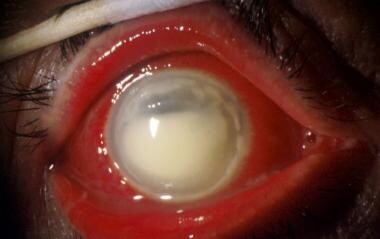Background
Chemical injuries to the eye represent one of the true ophthalmic emergencies, wherein time is truly critical. [1] While almost any chemical can cause ocular irritation, serious damage generally results from either strongly basic (alkaline) compounds or strongly acidic compounds. Alkali injuries are more common and can be more clinically challenging, with a significant potential for long-term morbidity. Bilateral ocular chemical exposure is especially devastating, often resulting in complete visual disability. Immediate, prolonged irrigation, followed by aggressive early management and close long-term monitoring, is essential to promote ocular surface healing and to provide the best opportunity for visual rehabilitation. [2, 3, 4]
Pathophysiology
The severity of this injury is related to chemical composition, pH, volume, concentration, duration of exposure, and the degree of penetration of the chemical. The mechanism of injury differs slightly between acids and alkali. [5]
Acid injury
Acids dissociate into hydrogen ions in the cornea. This usually occurs when a strong acid has a pH of less than 4. The hydrogen molecule damages the ocular surface by altering the pH, whereas the anion causes protein denaturation, precipitation, and coagulation. Protein coagulation creates a barrier and thus generally prevents deeper penetration of acids and is responsible for the ground glass appearance of the corneal stroma following acid injury. Hydrofluoric acid is an exception; it behaves like an alkaline substance because the fluoride ion has better penetrance through the stroma than most acids, leading to more extensive anterior segment disruption. [5]
Alkali injury
Alkaline substances are lipophilic and can penetrate cell membranes. They dissociate into a hydroxyl ion and a cation in the ocular surface. The hydroxyl ion saponifies cell membrane fatty acids, whereas the cation interacts with stromal collagen and glycosaminoglycans. This interaction facilitates deeper penetration into and through the cornea and into the anterior segment. Subsequent hydration of glycosaminoglycans results in stromal haze. Collagen hydration causes fibril distortion and shortening, leading to trabecular meshwork alterations that, in turn, result in increased intraocular pressure (IOP), sometimes permanent. Additionally, the inflammatory mediators released during this process stimulate the release of prostaglandins, which can further increase IOP. [6]
Epidemiology
Frequency
United States
Chemical injuries are responsible for approximately 7% of work-related eye injuries treated at US hospital emergency departments. [7] More than 60% of chemical injuries occur in workplace accidents, 30% occur at home, and 10% are the result of an assault. [8] Thus, 90% result from accidental exposures. Safety glasses can help prevent injuries, but industrial accidents often involve chemicals under high pressure. Safety glasses are not of much defense in this setting.
Mortality/Morbidity
As many as 20% of chemical injuries result in significant visual and cosmetic disability; only 15% of patients with severe chemical injuries achieve functional visual rehabilitation.
Race
No overall racial predilection exists; however, young black males are more likely to have high-concentration, high-impact alkaline chemical injuries secondary to assault. [9]
Sex
Males are three times more likely to experience chemical injuries than females. [8]
Age
Chemical injuries can strike any population; however, most injuries occur in patients aged 16-45 years. [7, 8]
Prognosis
In general, the prognosis of ocular chemical injuries is directly correlated with the severity of insult to the eye and adnexal structures.
Many classification systems and revisions thereof have been aimed at classifying ocular burns in relation to their prognosis, including the following systems: Thoft, Hughes, Roper-Hall, and Pfister. [10] In essence, all systems aim to quantify the degree of corneal epithelial involvement, the degree of limbal stem cell loss, and the degree of conjunctival involvement. [11]
Injuries can be graded from 0-5, as follows:
-
Grade 0 - Minimal epithelial defect, clear corneal stroma, no limbal ischemia
-
Grade 1 - Partial-complete epithelial defect, clear corneal stroma, no limbal ischemia, corneal epithelial involvement only
-
Grade 2 - Partial-complete epithelial defect, mild stromal haze, none or only mild limbal ischemia
-
Grade 3 - Complete epithelial defect, moderate stromal haze, less than one third of the limbus is ischemic
-
Grade 4 - Complete epithelial defect, stromal haze blurring iris details, one third to two thirds of the limbus is ischemic
-
Grade 5 - Complete epithelial defect, stromal opacification, greater than two thirds of the limbus is ischemic
Grades 0-2 can be expected to heal well with proper care and follow-up examinations.
The course for grades 3-5 is more tenuous and may require surgical intervention, in the form of either limbal stem cell transplantation to regenerate the ocular surface or penetrating keratoplasty to replace the corneal stroma and endothelium. These cases have a much poorer prognosis.
Higher-grade injuries are more susceptible to secondary complications. Grading of the severity can offer the patient a better idea of the prognosis. Therefore it is important to note the amount of limbal, corneal and conjunctival involvement at the time of the initial injury and to document changes over time.
Patient Education
If the injury resulted from a preventable accident, proper safety instruction should be provided.
If a patient is left functionally monocular from an injury, the patient should be instructed in the use of safety eyewear (eg, polycarbonate lenses).
For excellent patient education resources, visit eMedicineHealth's First Aid and Injuries Center and Eye and Vision Center. Also, see eMedicineHealth's patient education articles Chemical Burns, Chemical Eye Burns, and Eye Injuries.
-
Alkali burn. Note the severe conjunctival reaction and stromal opacification blurring iris details inferiorly.
-
Severe chemical injury with early corneal neovascularization.
-
Complete cicatrization of the corneal surface following chemical injury.









